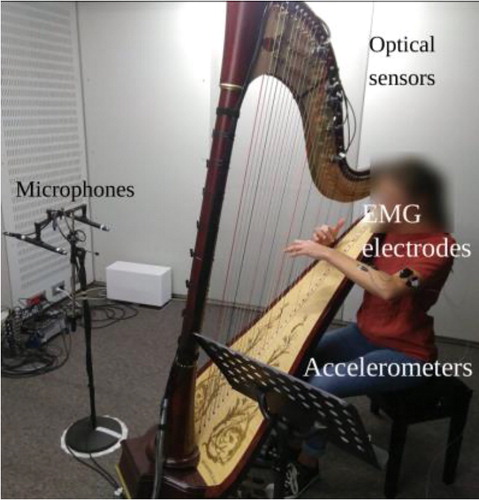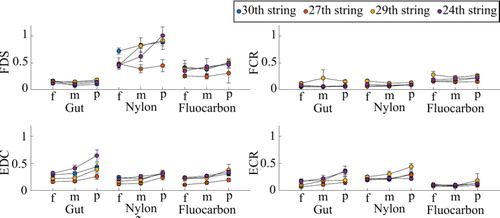1. Introduction
The repetition of fast and repetitive movements as well as the effort required to set the instrument into vibration is a common source of musculoskeletal disorders for musicians (Blanco-Piñeiro et al. Citation2017). In the case of plucked string instruments, the plucking force is directly related to the strings’ tension. Consequently, the choice of the strings has to be made based on both, the musician feel while playing (sound and tactile feedbacks), and the musculoskeletal consequences. In the case of the concert harp, the plucking action has been investigated in various musical contexts revealing plucking forces up to 30 N (Chadefaux et al. Citation2012). Kinematical and dynamical studies have been also conducted, underlining the specificity and repeatability of the ancillary and sound-producing gestures (Chadefaux et al. Citation2013). However, up to now, no study has analyzed together the plucking action and the underlying upperlimb biomechanics. The objective of the present study is to provide a more complete understanding of how the string properties and the dynamics affect the biomechanics of harp playing.
2. Methods
2.1. Experimental procedure
Nine musicians were involved in three experimental sessions (). At each session, a new stringing was mounted on the concert harp (CAMAC Harps, Atlantide Prestige model): gut, nylon, fluocarbon. Musicians were asked to perform an arpeggio sequence at 80 bpm, under three different dynamics (piano, mezzoforte, forte) according to their own judgement. The sequence has been repeated five times at each dynamics in a randomized order to avoid fatigue or learning effect.
Among the sixteen strings involved in the arpeggio, the bidimensional movement of four strings () has been measured using optical sensors (Le Carrou et al. Citation2014). Accelerometers (PCB 352C65, Fs = 25,600 Hz) were fixed on the soundboard to measure its vibration. Finally, EMG signals from four forearm muscles (flexor digitorum superficialis (FDS), flexor carpi radialis (FCR), extensor digitorum communis (EDC), and extensor carpi radialis (ECR)), were collected using a wireless system (Delsys Trigno, Natick, MA, USA, Fs = 1925 Hz). Electrodes were positioned, after skin preparation, on the muscles bellies. A maximum voluntary contraction (MVC) task was performed at the beginning of each session.
Table 1. Propert of the studied strings: number (#), frequency (F0), and tension (T) for the three stringings.
2.2. Data analysis
The note onsets have been higligthed using a threshold detection on the optical sensors signals. First, the RMS signals of the soundboard acceleration, referred to as Rstr=(30, 29, 27, 24), were computed on a 500 ms window, starting at each note onset. Rstr were finally normalized by the maximum value reached over the three sessions. Secondly, EMG signals passed through a bandpass filter and full-wave rectifier with zero phase shift ([20–400] Hz; 4th order Butterworth). The associated RMS signals were calculated using a 500 ms moving window, and divided by the MVC value. AEMG=(FDS, FCR, EDC, ECR), was obtained by averaging the RMS signals over the plucking action, i.e., during the last 300 ms before the note onset (Chadefaux et al. 2012). ÃEMG was finally defined by dividing AEMG by Rstr. At last, each descriptor has been averaged over all participants.
3. Results and discussion
Rstr averaged over the four investigated notes and the three stringings, was estimated at 82 ± 5%, 49 ± 4%, and 27 ± 3% when playing forte, mezzoforte, and piano, respectively. The dynamics instruction was therefore well-followed by the musicians with no obvious difference between the notes or the stringings.
AEMG, averaged over the three dynamics, indicated that the fingers’ muscles were more activated than wrist’s muscle, as well as a higher activation of FDS than EDC (AFDS = 19 ± 11%, AFCR = 6 ± 3%, AEDC = 12 ± 2%, and AECR = 8 ± 3%).
presents the evolution of ÃEMG with respect to the dynamics and the stringing for each investigated note. As expected, no important effect of the playing dynamics was observed, conveying that the muscular activation increased with the dynamics. ÃEDC and ÃECR showed a slight increase while the dynamics decreases. This observation is likely to be related to the joint stabilization during playing. Regarding finally the stringing properties, indicated that ÃFDS is greatly affected by the stringing. The activation was estimated at 0.13 ± 0.03, 0.67 ± 0.22, and 0.38 ± 0.09 for the gut, the nylon, and the fluocarbon stringings, respectively. It suggests that muscular activation increases when playing less stretched stringing. An explanation could be that a higher control is required when plucking a low stretched than high stretched string to provide it the desired motion.
4. Conclusions
This study has investigated how the harp stringing affect the forearm muscle activation. The main contribution is that FDS is highly related to the stringing properties and the playing control, while the extensor muscles are most likely to be related to the joints stabilization. Future work will include co-contraction to get insight into the playing control, especially regarding joint stabilization.
Acknowledgements
The author would like to thank the Collegium Musicae of Sorbonne Université for funding this project and the harpists who participated in this study.
References
- Blanco-Piñeiro P, Dìaz-Pereira MP, Martìnez A. 2017. Musicians, postural quality and musculoskeletal health: a literature's review. J Body Mov Ther. 21(1):157–172.
- Chadefaux D, Le Carrou JL, Fabre B, Daudet L. 2012. Experimentally based description of harp plucking. J. Acoust. Soc. Am. 131(1):844–855.
- Chadefaux D, Le Carrou JL, Wanderley M, Fabre B, Daudet L. 2013. Gestural Strategies in the Harp Performance. Acta Acust United Ac. 133(4):2444–2455.
- Le Carrou JL, Chadefaux D, Seydoux L, Fabre B. 2014. A low-cost high-precision measurement method of string motion. J Sound Vib. 333(17):3881–3388.


